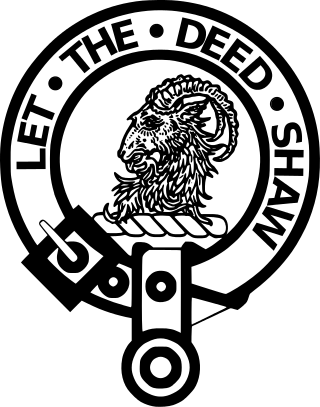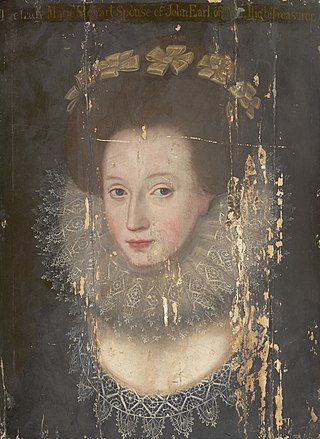There are currently two earldoms of Mar in the Peerage of Scotland, and the title has been created seven times. The first creation of the earldom is currently held by Margaret of Mar, 31st Countess of Mar, who is also clan chief of Clan Mar. The seventh creation is currently held by James Erskine, 14th Earl of Mar and 16th Earl of Kellie, who is also clan chief of Clan Erskine.

The title Earl of Kellie or Kelly is a title in the Peerage of Scotland, created in 1619 for Sir Thomas Erskine, who was Captain of the Guard and Groom of the Stool for James VI. It is named after Barony of Kellie in Fife, Scotland. Since 1875, it has been held jointly with the Earldom of Mar.

The Mormaer or Earl of Buchan was originally the provincial ruler of the medieval province of Buchan. Buchan was the first Mormaerdom in the High Medieval Kingdom of the Scots to pass into the hands of a non-Scottish family in the male line. The earldom had three lines in its history, not counting passings from female heirs to sons. Today, it is held by the Erskine family as a peerage. The current holder is Harry Erskine, 18th Earl of Buchan.

Kildrummy Castle is a ruined castle near Kildrummy, in Aberdeenshire, Scotland. Though ruined, it is one of the most extensive castles dating from the 13th century to survive in eastern Scotland, and was the seat of the Earls of Mar. It is owned today by Historic Environment Scotland and is open to the public as a scheduled ancient monument with gardens that are included in the Inventory of Gardens and Designed Landscapes in Scotland.

Clan Mackay is an ancient and once-powerful Highland Scottish clan from the far North of the Scottish Highlands, but with roots in the old Kingdom of Moray.

Clan Farquharson is a Highland Scottish clan based at Invercauld and Braemar, Aberdeenshire, and is a member of the Chattan Confederation.

John Erskine, 1st Earl of Mar was a Scottish aristocrat and politician. He was the custodian of the infant James VI of Scotland and Regent of Scotland.

John Erskine, 2nd Earl of Mar was a Scottish politician, the only son of another John Erskine and Annabella Murray. He is regarded as both the 19th earl and the 2nd earl.

Clan Sutherland also known as House of Sutherland is a Highland Scottish clan whose traditional territory is the shire of Sutherland in the far north of Scotland. The chief of the clan was also the powerful Earl of Sutherland, however in the early 16th century this title passed through marriage to a younger son of the chief of Clan Gordon. The current chief is Alistair Sutherland who holds the title Earl of Sutherland.

Clan Sinclair is a Highland Scottish clan which holds the lands of Caithness, the Orkney Islands, and the Lothians. The chiefs of the clan were the Barons of Roslin and later the Earls of Orkney and Earls of Caithness.

Clan Murray is a Highland Scottish clan. The chief of the Clan Murray holds the title of Duke of Atholl. Their ancestors were the Morays of Bothwell who established the family in Scotland in the 12th century. In the 16th century, descendants of the Morays of Bothwell, the Murrays of Tullibardine, secured the chiefship of the clan and were created Earls of Tullibardine in 1606. The first Earl of Tullibardine married the heiress to the Stewart earldom of Atholl and Atholl therefore became a Murray earldom in 1626. The Murray Earl of Atholl was created Marquess of Atholl in 1676 and in 1703 it became a dukedom. The marquess of Tullibardine title has continued as a subsidiary title, being bestowed on elder sons of the chief until they succeed him as Duke of Atholl.

Clan Drummond is a Highland Scottish clan. The surname is rendered "Druimeanach" in modern Scottish Gaelic.

Clan Cochrane is a Scottish clan of the Scottish Lowlands.

Clan Lennox is a Lowland Scottish clan. The clan chiefs were the original Earls of Lennox, although this title went via an heiress to other noble families in the fifteenth and sixteenth centuries. The chiefship of the clan then went to the Lennox of Woodehead branch.

Clan Ogilvy/Ogilvie is a Scottish Highland clan from Angus, Scotland. Gillebride, Earl of Angus, received a barony from King William the Lion in 1163 and bestowed the lands of Ogilvy upon his son Gilbert. In 1491, King James IV elevated Sir James Ogilvy as Lord Ogilvy of Airlie.

Clan Mar is a Scottish clan of the Scottish Lowlands. It is also officially known as the Tribe of Mar. The chiefs of the Clan Mar were the original Earls of Mar, although this title later went via an heiress to the Douglases in the late fourteenth century, and then to the Stewarts before going to the Erskines. The current chief of Clan Mar is Margaret of Mar, Countess.

Clan Stewart (Gaelic: Stiùbhart) is a Scottish Highland and Lowland clan. The clan is recognised by Court of the Lord Lyon; however, it does not have a Clan Chief recognised by the Lord Lyon King of Arms. Because the clan has no chief it can be considered an armigerous clan; however, the Earls of Galloway are now considered to be the principal branch of this clan, and the crest and motto of The Earls of Galloway's arms are used in the Clan Stewart crest badge. The Court of the Lord Lyon recognises two other Stewart/Stuart clans, Clan Stuart of Bute and Clan Stewart of Appin. Clan Stuart of Bute is the only one of the three clans at present which has a recognised chief.

Clan Fleming is a Lowland Scottish clan and is officially recognized as such by the Lord Lyon King of Arms. However, as the clan does not currently have a chief that is recognized by the Lord Lyon King of Arms it is therefore considered an armigerous clan.

Marie Stewart, Countess of Mar (1576-1644) was a Scottish courtier. She was the daughter of Esmé Stewart, 1st Duke of Lennox, a favourite of James VI of Scotland, and Catherine de Balsac. After her marriage, as was customary in Scotland, she did not change her name, and signed her letters as "Marie Stuart".
John Erskine, 3rd Earl of Mar was a Scottish landowner.




















